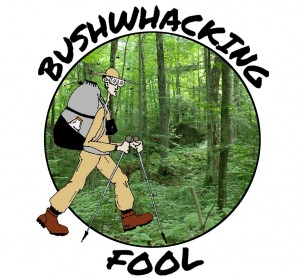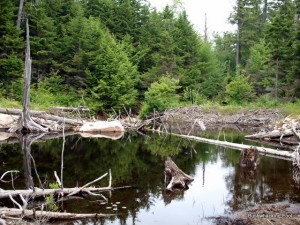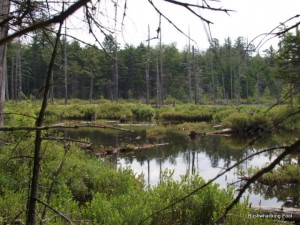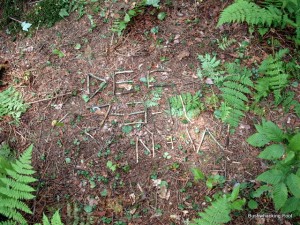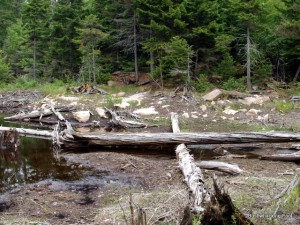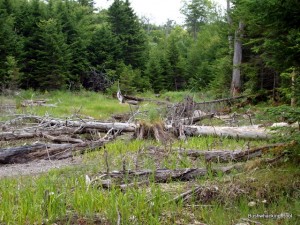The following is a description of an eight-day bushwhacking adventure into some of the most remote areas within the Five Ponds Wilderness in the northwestern Adirondacks. The trip includes traversing areas of intense blowdown along the oddly-shaped Oven Lake, exploring a cluster of wilderness ponds and following the wild Robinson River. The first part of day six includes a bushwhack to Gal and West Ponds from Cracker Pond.
Section Stats:
Date: July 3, 2011
Length: 0.5 miles (0.5 miles for the day)
Difficulty: Moderate
Thunderstorms awake me before dawn at my campsite near Cracker Pond. None come very close to my location but the sound of the thunder echoing off the hills surrounding the pond causes me great unease. Ever since experiencing the 1995 Microburst, I feel very uncomfortable in the woods during a thunderstorm; I cannot shake the feeling that one of these storms might decide to finish what it failed to do during that historical and devastating storm.
The rain accompanying the thunder only falls heavily for a brief moment; just enough time to get everything from the canopy foliage to the herbaceous ground plants saturated with moisture. Oh joy! Now I am guaranteed to get soaking wet this morning.
View View Day Six, Part One in a larger map
The sudden moisture awakens the mosquitoes in droves. Still wrapped in my comfortable sleeping bag![]() , I hear the drone for the swarm surrounding my tarp. The combined hum of the swarm sounds as if a single giant mosquito is hovering just beyond the tarp’s thin green fabric. I nervously wait for a proboscis the size of a fencing foil to pierce the tarp and imbede itself into my body; sucking out every drop of my blood and leaving me a shriveled raison of a human. Hopefully, the bushwhacking breadcrumbs I left behind would be enough for any rescuers to locate my body.
, I hear the drone for the swarm surrounding my tarp. The combined hum of the swarm sounds as if a single giant mosquito is hovering just beyond the tarp’s thin green fabric. I nervously wait for a proboscis the size of a fencing foil to pierce the tarp and imbede itself into my body; sucking out every drop of my blood and leaving me a shriveled raison of a human. Hopefully, the bushwhacking breadcrumbs I left behind would be enough for any rescuers to locate my body.
My woolgathering is interrupted by the ”rat-ta-ta-tat” of a yellow-bellied sapsucker pounding on a tree just above my tarp. When I crane my head at the front end of my tarp to try to catch a glimpse of the sapsucker, I notice sunshine piercing the cloud cover and hitting the wet forest floor. With the sapsucker quickly forgotten, I try to find the break in the clouds overhead but I am unable to see anything other than overcast.
The frequent slivers of sunshine coax me out of both my sleeping bag![]() and tarp, but the sky remains largely dark and gloomy. As I set about making breakfast, I keep hearing this frequent rumbling in the distance. It does not sound like thunder but more like a boat breaking through waves repeatedly. I have heard this sound before and in many places in the northwestern Adirondacks. Is it my imagination? Or is it real?
and tarp, but the sky remains largely dark and gloomy. As I set about making breakfast, I keep hearing this frequent rumbling in the distance. It does not sound like thunder but more like a boat breaking through waves repeatedly. I have heard this sound before and in many places in the northwestern Adirondacks. Is it my imagination? Or is it real?
Despite the morning rain and the rumblings (be they imaginary or not), the morning bird chorus is as active as ever. The bird chorus can be heard here, here and here. The buzzing you hear in the background of these recordings is not distortion but just millions of mosquitoes and a few deer flies stupid enough to be caught underneath my tarp.
The sound of a frantic hooded merganser female interrupts my puzzled pondering. Apparently she is in search of her young, as she persistently and frequently quacks while swimming around the perimeter of the pond near my campsite. I hope she eventually found them safe and sound.
It is quarter to eleven by the time I am pack up and am completely ready to head off to Gal Pond. After reaching Gal, my plan is to turn west for the first time during this entire trip and over multiple days make my way back toward Bear Pond Road and hopefully my car. West Pond is my final destination for the day, thus making today another rather short bushwhack, much like yesterday.
I head off at a bearing of 342 degrees, quickly leaving Cracker Pond behind. Within ten minutes I descend a short but steep slope to a grassy wetland (see point #60). The outlet from Cracker Pond meanders through the middle of the wetland but the ground appears somewhat solid off to the west.
Unfortunately, the thigh-high grass I wade through upon entering open area is completely saturated with rainfall. Thankfully, I am wearing my Golite Tumulao rain pants![]()
and therefore remain relatively dry. I keep my lightweight and homemade hiking poles out in front of me, waving them to and fro so as to knock as much of the morning moisture from the grass before stepping through it.
As I continue north around the perimeter of the wetland, the open meadow narrows and the outlet stream widens so I am forced to move off into the forest to the west. A tangle of blowdown along a slope blocks my path and despite giving it the “old-college try,” I am unable to find an easy way through it. Normally, I would just force my way through but with all the sharp softwood limbs still attached to the downed logs and the wet conditions, I decide a strategic retreat is preferable to ending up being impaled on one.
I backtrack through the grassy wetland, this time staying farther out in the clearing, testing the integrity of the soft ground. How could my rain pants, gaiters and hiking boots get any wetter on the outside than they already are now? Unfortunately, the same cannot be said for my hiking clothes against my skin. The humidity is so high that although I unzip my North Face rain jacket![]() and both pit-zips it does very little as my clothing stays damp and clammy throughout most of the day.
and both pit-zips it does very little as my clothing stays damp and clammy throughout most of the day.
I notice multiple piles of moose scat as I work myself through the wetland. Also, when crossing through the grassy meadow I stumble in what appears to be moose tracks several times. Moose obviously frequent this area almost as much like they did near the Riley Pond’s outlet and along the shore of Oven Lake.
Once back on the southern border of the wetland, I bushwhack through conifer forest to the southeast, crossing the outlet stream from Cracker Pond when I find an opportunity to do so. At this point I can once again see Cracker Pond through the forest (see point #61). After 30 minutes of bushwhacking I am nearly at the same point where I started. Not off to a great start this morning obviously. Thankfully, tomorrow is the long day along the Robinson River or I would be in some serious do-do right about now (to go with the trips theme it would be moose do-do, of course!).
Now following along the outlet stream on its eastern shore, I remove my sweat-saturated compass from inside my rain jacket and take a new bearing of 332 degrees. And as usual the compass directs me to head right into the thickest portion of the forest. Sometimes I feel as if the compass is completely unnecessary and all I have to do is look around for the most difficult conditions and head in that direction.
Once again I turn away from Cracker Pond and head back toward the grassy wetland, except this time on the eastern side of the outlet stream. As I approach the open wetland again, the terrain slopes downward toward the grassy opening and frequent blow downs of large white pine trees block my path. I weave around the large tip-up mounds when I can and crawl over the large downed logs when I have no other choice. I observe occasional piles of moose scat and some hoof prints but no live specimens around the blowdowns.
Luckily, the swath of blowdowns is fairly narrow, and soon I pass the wetland and head up onto a ridge. As I climb the low ridge, the conifer forest along the wetland slowly transitions to hardwoods and the going becomes increasingly easier.
After clearing the ridge, I descend down to an old beaver pond and the forest transitions back to conifers near its border. The beaver pond has definitely seen better days. The pond is a narrow sliver of an opening, oriented east to west and surrounded by dense coniferous forest.
I arrive directly across from the dam, which has a large, gaping hole in the middle. Surrounding the small stygian pool is a mud flat with small, nascent grasses and sedges sprouting up. The farther from the water, the taller and more established are the ground vegetation, including a plentiful supply of carnivorous sundews.
Scattered about, lying in the mud and on top of each other, are large, rotten logs, stumps and other debris left over from the beaver pond’s better days. Bare rock lies scattered around the edge of the old beaver pond, bleached by the sun to a dull white. The forest along the edge is entirely young spruce and fir, a scab on the healing wound left from a period of beaver activity long past.
Stay tuned for a description of the rest of my trip to Gal Pond later in the week.
Affiliate Disclaimer: Some links within this blog post may send you to a retailer website. If you chose to purchase any product at that site at that time the author will receive a small commission. These commissions provide compensation for the author’s time and effort necessary to provide the amazing content at the Bushwhacking Fool.
